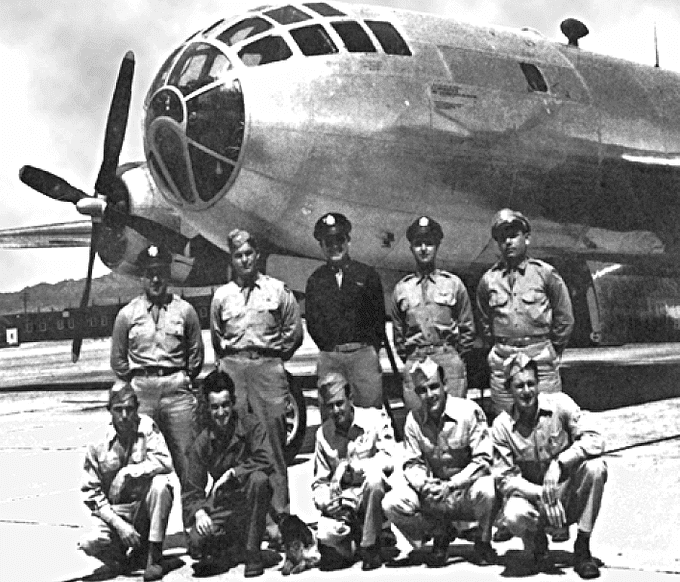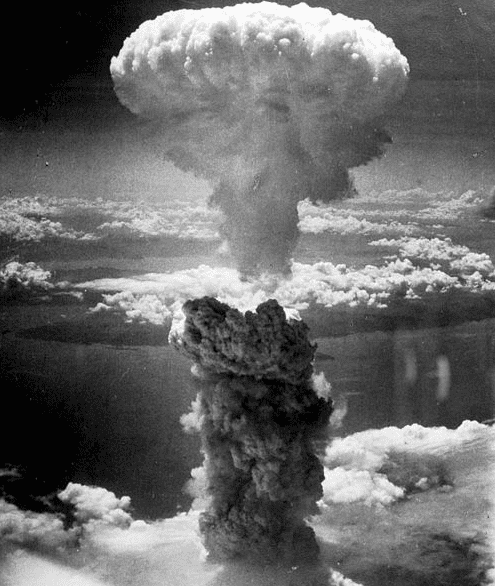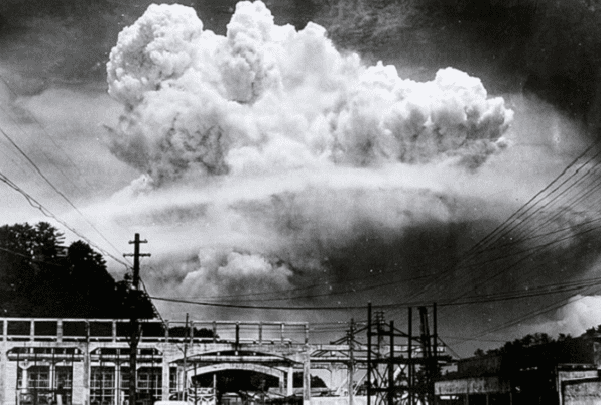Three days after the Japanese city of Hiroshima was destroyed by the first-ever use of an atomic bomb during warfare, a second Japanese city, Nagasaki, was similarly devastated when the U.S. B-29 bomber Bockscar dropped the atomic bomb “Fat Man” on 9 August 1945. An estimated 40,000 people were instantly killed from flash burns, while radiation sickness and other illness killed another 40,000 in the following months. Almost all the fatalities in both Hiroshima and Nagasaki were civilians.

The American rationale for using these terrifying new weapons was to overwhelm the Japanese people into surrendering, ending World War II without a prolonged, bloody invasion of the Japanese homeland. The Allies had issued the Potsdam Declaration on July 26 warning Japan that if it did not surrender, “the inevitable and complete destruction of the Japanese armed forces and just as inevitably the utter devastation of the Japanese homeland” would follow. Japan did refuse to surrender, and so President Harry S. Truman authorized the two atomic bomb attacks. Six days after Nagasaki was attacked, Japanese Emperor Hirohito announced that Japan would surrender.
Other historians contend that the atomic bombings were unnecessary, since the Japanese had already been severely weakened by a six-month fire-bombing campaign against 67 Japanese cities that preceded the attacks on Hiroshima and Nagasaki. On the very day that Nagasaki was attacked, August 9, Russia had declared war on Japan – and some critics say the real reason for the atomic bombings was to show off these powerful new weapons to intimidate Russia.
Another controversy, of course, is the ethical question of whether it is ever justified to split atoms to kill tens of thousands of civilians.

The following two newspaper articles are about the atomic bombing of Nagasaki. The first article is a news report published the day of the attack. The second article, published the day after, gives some vivid, first-hand descriptions of the bomb’s enormous explosion, provided by American pilots.
Here is a transcription of this article:
Planes Drop Atom Bomb No. 2 on Nagasaki
Strategic War City Vulnerable
Results of Raid Held until Return of B-29 Fleet
Guam, Aug. 9 (AP) – The world’s second atomic bomb, most destructive explosive invented by man, was dropped on strategically important Nagasaki on western Kyushu island at noon Thursday.
Crew members radioed that results were good, but Gen. Carl L. Spaatz said additional details would not be disclosed until the mission returns.
Spaatz’ communiqué reporting the bombing did not say whether only one or more than one “mighty atom” was dropped.
First Sears Hiroshima
The first atomic bomb destroyed more than 60 per cent – 4.1 square miles – of Hiroshima, city of 343,000 population, Monday, and Radio Tokyo reported “practically every living thing” there was annihilated.
Use of the awesome atomic bomb on Nagasaki came just after Japan had had time to assess the damage wrought at Hiroshima, which was one of the enemy cities best prepared to fight fires caused by bombing.
Nagasaki, with its closely-packed houses, was believed to be more vulnerable.
Although the second A-bomb was dropped on the day Russia went to war with Japan, it was not believed here there had been any plan to make the two simultaneous.
Nagasaki Favorite Target
Nagasaki, which had 211,000 population ten years ago, is an important shipping and railway center. It was hit first by China-based B-29s a year ago this month and was heavily attacked by Far East air force bombers and fighters only last July 31 and on the following day.
Nagasaki, although only two-thirds as large as Hiroshima in population, is considered more important industrially. With a population now estimated at 255,000, its 12 square miles are jam-packed with eave-to-eave buildings which won it the name “sea of roofs.”
It was vitally important as a port for trans-shipment of military supplies and the embarkation of troops in support of Japan’s operations in China, Formosa, Southeast Asia and the Southwest Pacific. It was highly important as a major shipbuilding and repair center for both naval and merchantmen.
Suburbs Boost Area
The city also included industrial suburbs of Inase and Akunoura on the western side of the harbor, and Urakami. The combined area is nearly double Hiroshima’s.
Japanese perished by uncounted thousands from the searing, crushing atomic blast that annihilated 60 per cent of Hiroshima, photographic and other evidence indicated Thursday.
Tokyo Radio, which said that “all living things, human and animal, were literally seared to death,” reported that authorities were still unable to check the total casualties.
Photographs showed that not even stout concrete structures in the heart of the city, presumed to have been air raid shelters, escaped. The structures still stood but all the insides were apparently burned out.
Both Gen. Carl Spaatz, who announced from his strategic air force headquarters here that 60 per cent of Hiroshima had been “completely destroyed,” and Tokyo Radio warned that more atomic bombs could be expected.
Spaatz declared that other Superforts were ready to follow the B-29 “Enola Gay” which Col. Paul W. Tibbets Jr. of Miami, Fla., piloted over Hiroshima to drop war’s newest and most devastating weapon.
The photographs disclosed that the damage extended beyond the area of complete destruction.
Here is a transcription of this article:
Nagasaki Went Up in Smoke When Struck by Atomic Bomb
Inferno Could Be Seen 250 Miles Away, Yank Fliers Say –
Towering Column of Flame Rose 10 Miles into Stratosphere
Guam (UP) – The second atomic bomb dropped on Japan obliterated Nagasaki in an inferno of smoke and flame that swirled more than 10 miles into the stratosphere and could be seen for 250 miles, an Okinawa dispatch said today.
Okinawa-based pilots attacking other objectives on Kyushu yesterday said the clouds of smoke from Nagasaki spread rapidly until they obscured bombing targets 60 miles from the port.
Fliers told United Press War Correspondent Russell Annabel at Okinawa that the atomic bomb explosion was “too tremendous to believe.” One said that the blinding glare of the blast was so great that when it faded he thought for a moment the sun was setting.
The airmen’s stories bolstered a growing belief that the entire urban or built-up area of Nagasaki, major naval base, industrial centre and Japan’s 11th city, was destroyed by the atomic bomb.
The built-up area totaled only four square miles. Four and one-tenth square miles of Hiroshima were leveled Monday when the first atomic bomb was dropped on Japan.
Accurate assessment of the destruction at Nagasaki awaited reconnaissance photographs. Reconnaissance planes which flew over the city three hours after the attack said smoke rising to 20,000 feet still covered the centre of the city.
Photographs taken at the time showed scattered fires outside the smoke area, General Carl A. Spaatz, commander of the strategic air forces, said.
Radio Tokyo still remained silent on the results of the attack, which almost certainly killed tens of thousands of Japanese. It did denounce the Hiroshima raid again as a “barbarous atrocity” in which the city’s population was “snuffed out without being given a chance to lift a finger either in defense or defiance.”
Japanese propaganda cries against the inhumanity and lawlessness of the atomic bomb attack left the Americans unmoved, however. Spaatz said American planes were dropping 3,000,000 leaflets a day on Japan telling her that she will be atom-bombed “again and again” until she surrenders.
The leaflets called on the Japanese people to “petition the Emperor to end the war.”
“You should take steps now to cease military resistance,” the leaflets said. “Otherwise, we shall resolutely employ this bomb and all of our other superior weapons promptly and forcefully to end the war.”
On Okinawa, two army Mustang pilots told how they watched the blast of the atomic bomb on Nagasaki from the area of Yaku Island, almost 250 miles to the southeast.
Even from that distance, Lieutenant Colonel Edward F. Rhoddy of Cleveland and Major Howard Tuman of Venice, Calif., said they saw a huge ball of yellow and orange fire shoot 8,000 feet into the sky.
Lieutenant Colonel William Banks of Raleigh, W. Va., in a plane about 140 miles from Nagasaki, said he saw a black cloud rising in the shape of a gigantic inverted cone.
“It was the most amazing thing I ever saw in my life,” he said.
Lieutenant Otto Schumacher of Walhalla, S.C., a veteran of 49 missions in the European theatre, was in an Invader attack bomber 80 miles away when he saw the explosion. He said smoke spread over an area of no fewer than 20 square miles.
Lieutenant Nolan Jones of Waldron, Ark., a fighter pilot, said: “When you see something climb from 140 miles away it’s really moving. I turned my gunsight on the column and the top of the cloud filled the sight ring. At 1,000 feet a 70-foot target will exactly fill the ring. On the basis of that measurement, the column towered 53,550 feet.”
Captain William R. Wilson of Crisfield, Md., said the glow was so intense that “when it faded I had the impression the sun was setting.”
Note: An online collection of newspapers, such as GenealogyBank’s Historical Newspaper Archives, is not only a great way to learn about the lives of your ancestors – the old newspaper articles also help you understand American history and the times your ancestors lived in, and the news they talked about and read in their local papers. Did any of your ancestors serve in World War II? Please share your stories with us in the comments section.
Related WWII Articles:
